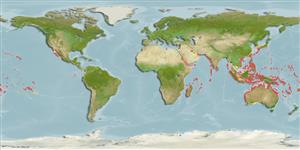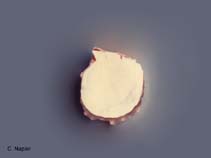Pinctada maculata (Gould, 1850)
| Native range | All suitable habitat | Point map | Year 2050 |

|
| This map was computer-generated and has not yet been reviewed. |
| Pinctada maculata AquaMaps Data sources: GBIF OBIS |
Classification / Names Common names | Synonyms | CoL | ITIS | WoRMS
Gastropoda | Ostreida | Margaritidae
Environment: milieu / climate zone / depth range / distribution range Ecology
Benthic; depth range 0 - 20 m (Ref. 348). Tropical
Distribution Countries | FAO areas | Ecosystems | Occurrences | Introductions
Indo-Pacific and North Atlantic: from Cocos (Keeling) Islands to eastern Polynesia; north to Japan and south to northern New South Wales, Kermadec, Norfolk and Lord Howe Islands.
Length at first maturity / Size / Weight / Age
Maturity: Lm ? range ? - ? cm Max length : 6.0 cm ShL male/unsexed; (Ref. 348); common length : 5.0 cm SL male/unsexed; (Ref. 348)
Short description Morphology
Shell rather thin and small, subquadrate in outline, with a short and ill-defined posterior ear which is not drawn out into a wing-like process. Anterior margin protruding only slightly or not at all beyond the tip of the anterior ear. Outer surface of shell, when not worn, covered with numerous, flattened and brittle, imbricating concentric scales bearing slender, radially projecting spines, especially toward the margins. Hinge lines with 2 small teeth on each valve; 1 rounded anterior tubercle just in front of the umbo, and 1 slightly slanting posterior ridge behind the ligamental area. Parallel accessory ridges sometimes developed on both valves, so that the posterior teeth appear double. Colour: outside of shell with a variable coloration, usually white to tan with a number of purple, or brown to black radiating bands and sometimes a superimposed pattern of finely wavy concentric lines of reddish brown. Internal nacreous area with pale yellow to deep orange-gold tint. Non-nacreous margin with white porcelaneous patches, generally alternating with irregular, dark purplish brown or black blotches.
Found in intertidal rock pools, to immediate subtidal depths on reefs (Ref. 377). Byssally attached to rocks, the underside of stones or coral pieces. Littoral and sublittoral to a depth of about 20 m. Extremely common in shallow water Polynesian lagoons. Produces regular but rather small yellow pearls. Locally exploited for its edible meat, golden nacreous shell and, sometimes, for pearls (Ref. 348).
Life cycle and mating behavior Maturity | Reproduction | Spawning | Eggs | Fecundity | Larvae
Members of the class Bivalvia are mostly gonochoric, some are protandric hermaphrodites. Life cycle: Embryos develop into free-swimming trocophore larvae, succeeded by the bivalve veliger, resembling a miniature clam.
Main reference
References | Coordinator | Collaborators
Poutiers, J.M. 1998. (Ref. 348)
IUCN Red List Status (Ref. 130435)
CITES status (Ref. 108899)
Not Evaluated
CMS (Ref. 116361)
Not Evaluated
Threat to humans
Harmless
Human uses
| FishSource |
Tools
More information
Internet sources
BHL | BOLD Systems | CISTI | DiscoverLife | FAO(Publication : search) | Fishipedia | GenBank (genome, nucleotide) | GloBI | Gomexsi | Google Books | Google Scholar | Google | PubMed | Tree of Life | Wikipedia (Go, Search) | Zoological Record
Estimates based on models
Preferred temperature
(Ref. 115969): 23.6 - 29.3, mean 28.3 (based on 3476 cells).
Price category
(Ref. 80766):
Unknown.



